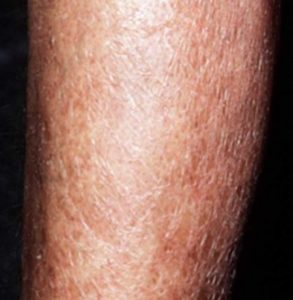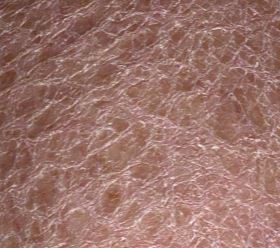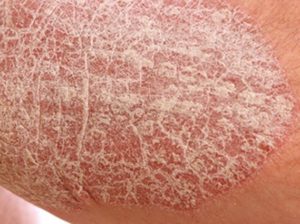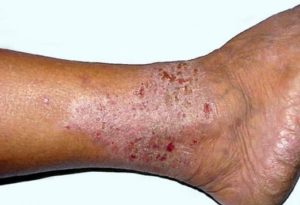Having a dry skin on legs is unattractive and boring. In most cases, dry skin on any part of the body is characterized by scaly, flaky and snake-like skin. With dry skin, you are likely to experience itching and cracking on legs. Dryness can occur due to a variety of reasons including diabetes, this is article provides an insight on the possible causes, how to treat and how to get rid of the dryness.

Dry skin between legs
Dry skin on legs is a very common condition in winter. The condition occurs when your skin loses its natural oil and moisture. Dry skin can occur any part of the body. Between legs, dry skin could occur as a result of irritation and friction between your legs and clothes or between your thighs when your move.
Although dry skin is not a serious health condition. It can, however, be very painful and irritating. As mentioned, the condition is common in winter, when the temperature levels drop, humidity (the amount of water vapor in the atmosphere) plunges, this with a dry atmosphere, your skin may lose a lot of water thus becoming dry and dehydrated.
This is a common condition for people who leave in the dessert. Other possible causes of dry skin between legs include:
- Using harsh soap and cosmetic products that rid the skin of the natural oils and water.
- Excessive scrubbing on the legs is another possible cause of dry skin. By now you should understand that out skin is the first line of defense against diseases and infection. The skin protects our internal organs from a viral, fungal and bacterial infection that might cause infections.
- Dry skin on legs can also be caused by aging or the occurrence of natural dry skin. As we age, the body start to reduce in functionality. The amount of sebum produced will gradually decrease, this is what causes the skin o become thin and patched.
- Dry skin on legs regardless of age can also be as a result of an underlying medical condition. Some of these conditions will include the following: diabetes (where the body is unable to secrete enough insulin), dermatitis (a common skin condition marked with red, swollen sores. The condition may at time be accompanied with small painful blisters) and psoriasis (also a skin condition marked by red, scaly patches)
Dry circle skin on legs
What could be causing the dry skin circles on your legs? Understanding the actual underlying cause of dry skin is the first answer to trying to deal with dry skin. We have seen that dry skin is harmless. The symptoms accompanying the dry skin on legs can, however, be very painful and irritating.
So what causes dry skin}? To answer that question. Here are some of the possible causes of dry skin on the leg and other parts of the body. Skin cancer on legs, lupus, hives, and vitiligo among others.
Dry skin on legs looks like snakeskin
Dry skin on legs and other body parts is a quite a common condition. Apart from making the skin appear like snakeskin, dry skin will cause your legs to become very itchy, and often rough. With dry skin, you are also more likely to have red patches that can be very itchy causing lots of discomforts.
Left unchecked, itching caused by dry skin could cause you to develop itchy circles, this is common during sleep when the conscious control of scratching is low. The appearance of dry skin is as a dull, rough skin with fine scales that may flake off easily.
Dry skin on legs looks like scales
Scaling is a common symptom of dry skin. Scales on the skin are the dry thin flakes of epidermis shed from the skin caused by continuous scratching of skin due to dry skin. In most cases, dry skin will be characterized with fine scaling of the skin and occasionally small cracks.
Regardless of what is causing the dry skin symptom such as itching will always be present.

Dry skin on legs pictures
Dry skin on legs varies in look depending on what the underlying condition. If the underlying condition causing the dryness is an underlying medical condition, even thought you might experience some symptoms (burning, itching, and irritation) with a person whose dry skin is caused by friction between legs, one would be more serious than the other.

This article continues different [photos and images of how different dry condition will look like. Be warned, some the images might be graphic. The images provided are to be used for illustration and not as a substitute for a professional health diagnosis.
Dry scaly skin on legs pictures
Here is how a dry scaly skin on legs will look like.
Dry skin on legs causes
Dry skin can be caused by a number of both environmental and medical conditions. Here are some possible causes of dry skin on legs and other parts of the body. Some of the causes are serious and as such immediate medical attention is required.
- Skin cancer, Skin cancer is the most common form of cancer. Skin cancer is the uncontrolled growth of abnormal skin cells. Cancer can be caused by UV radiation, genetic defects
- Lupus is a common skin condition marked by inflammation of the skin
- Seborrheic dermatitis, a chronic relapse and usually a mild form of skin dermatitis
- Hives also called urticaria, is a raised itchy rash that appears on skin
- Vitiligo this is a long term condition where white patches develop on skin, the condition is caused by lack of melanin in skin
- Cellulitis this is an infection of deeper layer of skin and tissue, left untreated, this condition can be dangerous
- Diaper rash this is the inflammation of the skin caused by prolonged contact with a damp diaper.
- Friction between thighs also called chafing
- Yeast infection, this is a fungal infection characterized by itching, burning sensation, soreness and pain
- Wearing tight clothes cloud also cause the irritation of the dermis which could lead to dry skin
- Harsh soaps and cosmetics may rid the skin of natural oils and moisture leading to dry skin on legs
- Dehydration is the harmful reduction in the amount of water in the body
- Hypothyroidism this refers to the abnormally low capacity of the thyroid glands
- Diabetes’s insipidus this is a condition in which the response of the pituitary hormone is impaired leading to large quantities of dilute urine. This could lead to dehydration which could then lead to dry skin
- Hashimoto’s disease also known as chronic lymphocytic thyroiditis, this condition is known to cause underactive thyroid glands. This condition is the main cause of hypothyroidism in the United States.
Dry wrinkled skin on legs diabetes
Diabetes is a condition in which the body becomes unable to respond to the hormone insulin. Abnormal concentration of insulin results in abnormal metabolism of carbohydrate and elevated levels of glucose in the blood and urine.
Tami Ross, a certified diabetes instructor who once served as the president of the American Association of Diabetes Educator once told health line that age 40 was the magic number when diabetes begins to sneak up on people.
Wrinkled skin might be a normal state of aging but could also mean you have diabetes. Here are some of the symptoms you need to be on the watch out for.
- Sudden vision changes
- Frequent thirst and urination
- Feeling hungry in short instances
- Unexplained fatigue and general body weakness
- Unusual skin patches on legs, hands, face and any part of the body
Extremely dry skin on lower legs
Extremely dry skin can be a cause for itching skin and many other symptoms. It is worth noting that nobody is immune to dry skin. Anybody regardless of age or gender can have dry skin once or twice. It is always important to seek the help of a dermatologist for skin symptoms that last for more than 2 days.
To soothe your skin of extremely dry skin, you can try the following:
- Nourishing moisturizers and soothing lotions
- Occlusive moisturizers such as a mild Vaseline that helps form a protective seal on skin
- Apply a cold compress in cases of sunburn-causing dry skin
- Avoid scratching the dry skin
- Avoid irritants such as harsh bathing soap and skin care products
- When showering, avoid steam or hot baths.
- Always wear sunscreen before going out.
Dry flaky skin on legs itchy
Dry flaky skin on legs that itch is a typical symptom of a skin condition known as ichthyosis Vulgaris. Also known as Autosomal dominant ichthyosis [Wikipedia], this is a skin condition characterized by the dry scaly skin. It is the most common form of ichthyosis (a heterogeneous genetic skin disorder). Statistic shows that the condition affects 1 in every 250 people.

Other condition that might result in the itching would include the following:
1) Hives on legs
Also called urticaria, hive is a rash of red welts on the skin. The condition is often characterized by intense itching around the affected area. Hives are sometimes accompanied by dangerous swelling caused by an allergic reaction to food.
Hive will last for some few days and do not leave any long lasting skin changes. The causes of these skin condition is either an infection or an allergic reaction to medication, insect bites on legs. Cold temperatures are also believed to cause the symptoms of hives on legs.
2) Chicken pox
Chickenpox is an infectious disease known to cause a mild fever and a rash of itchy inflamed blisters. Chicken is caused by herpes zoster virus, it is common in children who are afterward immune to future infection of the condition.
When chicken pox is the underlying cause of dry, flaky skin on legs, you would expect to observe the following symptoms:
- High body temperatures
- Itchy small blisters on body
- Loss of appetite
- Scabs and crust on skin
3) Eczema
Eczema is a skin in which the patches of skin becomes rough and inflamed. Eczema also known as atopic dermatitis is often accompanied by itching and bleeding caused by painful blisters. Eczema is a common condition that can affect anybody regardless of age or gender.
4) Seborrheic dermatitis
Sometimes referred to as, seborrheic eczema, this is a chronic relapsing and usually a mild form of dermatitis. With this condition, you are likely to see the following symptoms:
- The skin flakes especially on scalp
- You are likely to observe patches of greasy skin covered with flaky white scales
- Redness of the skin
Dry skin on legs treatment
The treatment for dry skin will vary depending on what the underlying cause of the dryness is. It is important to have a doctor diagnose the condition before you can attempt treating it. Over the counter creams and gel might worsen the condition.
For mild cases of dry skin, you can try applying a topical ointment like anti-itching creams, anti-inflammatory gels or just simple skin moisturizers and emollients. Antihistamine medication may be used in cases of allergic reaction causing dry skin whereas hydrocortisone lotion may be used to relieve the symptoms of dermatitis (red, itchy skin)
Avoid harsh soap and perfumed cosmetic products on legs until the condition clears.
You should also avoid scratching the area with dry skin or with the itchy rash. Doing so might worsen the condition and open you up for a possible skin infection.
Keep off from tight synthetic clothes that keep rubbing your legs or inner thigh.
The other thing you need to do is to make sure the room you are in is ok by plugging a humidifier and drinking plenty of water to make sure you remain hydrated.
Dry skin on legs home remedies
Not all cases of dry skin on leg require treatment. This is because not all cases of dry skin are painful of life threatening. To manage some of the symptoms of dry skin at home, you can try the following remedies.
Aloe Vera gel
Aloe Vera is a great home remedy for itching, inflammation and burning sensation, the typical symptoms of dry skin. Aloe Vera is also a great antioxidant with plenty of fatty acids that can be used to soothe the leg skin and relieve the itching, irritation, inflammation and burning sensation.
To use aloe Vera as a remedy, do the following:
- Wash your legs, or affected part of the skin with a mild soap and lukewarm water
- Pat it dry and apply aloe Vera gel
- You can use a parked gel from the drug store or extract a fresh gel from an aloe Vera leave
- Leave the paste on before rinsing it off with tap water
- Repeat this twice or thrice daily for effective results
Honey scrub
To soften your legs having a dry skin, you can also use honey. Raw honey is not only a great antioxidant but also a good antibacterial agent. Apart from relieving the itching and burning sensation caused by dry skin on legs, honey will help protect against potential bacterial or viral attract.
Natural yoghurt
Natural yogurt contains anti-inflammatory that might also work well with dry skin on legs. When applied on dry legs, yogurt can help soothe the dry skin. It is also rich in lactic acid that could kill bacteria that causes itching and dryness on the skin.
Cucumber
Cucumber is high in water. Since dry skin is essentially caused by lack of water in the skin, you could boost the amount of water in the skin by either eating a lot of cucumber on a day to day basis or rub it on the dry legs to moisturize and heal your skin of dryness.
Try avocado
Another great remedy you could try at home is an avocado. Yes! Avocados are great antioxidants, containing fatty acids and vitamin that could improve your skin from the inside. Vitamin A contained in avocados is great for nourishing and restoring the skin.
How to get rid of dry skin on legs overnight
Dry skin on legs can be very annoying especially at night. It could make you lose sleep, and the pain, itching and irritation caused by dry skin is just unbelievable. Here is how to get rid of dry skin overnight!
- Warm water shower, do not use too hot or steamy shower least you worsen the condition
- Do away with harsh soap, use a mild soap, and when you finished, pat your skin dry with a clean towel, being careful not to irritate your legs then
- Use a gently moisturizing on your skin. this time do not use any skin care product or wear irritating synthetic clothe
- Protect your skin from cold by wearing soaks or a pair of trousers
- If you still have the dry skin in the morning, please seek immediate medical attention.
Sources and references.
- Fight back against dry skin: http://www.webmd.com/beauty/dry-skin-13/dry-skin-causes
- Symptoms and causes of dry skin: http://www.mayoclinic.org/diseases-conditions/dry-skin/symptoms-causes/dxc-20248892
- What causes dry skin: http://www.healthline.com/symptom/dry-skin
- Dry, flaky legs, what’s the solution: https://www.theguardian.com/fashion/2013/jul/29/dry-flaky-legs-what-solution
- Healthy skin and hair guides: http://www.webmd.boots.com/healthy-skin/guide/causes-dry-skin
- Dry skin on legs: http://www.healtreatcure.org/dry-skin/dry-skin-on-legs-scales-snakeskin-itchy-get-rid-remedies/

Wow, that’s what I was searching for, what a material! present here at
this blog, thanks admin of this web site.
An intriguing discussion is definitely worth comment.
I think that you ought to write more on this issue, it may not be a taboo matter but generally people
do not discuss these issues. To the next! Cheers!!
I really appreciate your piece of work, Great post.
I wanted to thank you for this great read!! I certainly enjoyed every bit of it.
I have you bookmarked to check out new things you post?
My family members all the time say that I am wasting my time here at web, but I
know I am getting know-how everyday by reading such pleasant articles or
reviews.
Hello.This post was extremely motivating,
particularly because I was searching for thoughts on this subject last couple of days.
Regards for this marvellous post, I am glad I found this website on yahoo.
fantastic issues altogether, you simply won a new reader.
What could you recommend about your publish that you simply
made a few days in the past? Any positive?
Glad to be one of several visitants on this amazing internet site :D.
You will discover some intriguing points in time in this write-up but I don’t know if I see all of them center to heart. There is certainly some validity but I will take hold opinion till I appear into it further. Excellent post , thanks and we want additional!
Someone essentially help to make seriously articles I would state. This is the first time I frequented your web page and thus far? I surprised with the research you made to create this particular publish extraordinary. Wonderful job!
Rattling clear site, thanks for this post.
Hi there, after reading this awesome paragraph i am as well
delighted to share my experience here with friends.